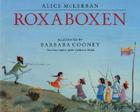 Your discussion of books about pretend play made me think of
Your discussion of books about pretend play made me think of Roxaboxen, another of those books that I'm surprised we haven't mentioned here. It's by Alice McLerran, wonderfully illustrated by Barbara Cooney (whom we also haven't mentioned enough).
McLerran writes about a group of children who create a whole city out of rocks, boxes, and various found objects in a vacant lot in Arizona.
Marion called it Roxaboxen. (She always knew the name of everything.) There across the road, it looked like any rocky hill -- nothing but sand and rocks, some old wooden boxes, cactus and greasewood and thorny ocotillo -- it was a special place.The story pulls you into the magic of creating something from imagination, and a group of mixed-age kids having fun with each other. It makes children want to get up and build a town. I knew that the story was based on McLerran's mother's own experience, but it turns out that the vacant lot was a specific place in Yuma, Arizona which has now been turned into a delightful-sounding park. It has a few benches and some signs and a lot of rocks to play with. Visitors are encouraged to donate rocks, knowing that they'll be added to the mix of stuff used by kids who play there.
So thinking about parks led me to Grant Park in Portland Oregon, in Ramona Quimby's neighborhood. We came upon it on our cross-country trip ten years ago, not far from where cousin Kate then lived. It's a nice comfy city park, with playing fields and trees, and in one corner of it are three statues and some very kid-friendly fountains:
Ramona Quimby, Ribsy, and Henry Huggins are right there, to be played with and splashed around. Ramona is wearing her boots and seems to be in the scene where she's a kindergartner stuck in the mud in Ramona the Pest. There's even a map of the neighborhood, marking places where events in the books happened.
Love,
Deborah



Lots to think about here.
ReplyDeleteFirst, you made me realize that I don't seem to like books that are mainly about pretend play. It's kind of like my aversion to plays-within-a-play (like in old musicals, like South Pacific and The King and I - I love those shows but the play-within-a-play is my least favorite part; same with the dream sequence in Oklahoma). I'm not sure why - I guess I feel like I'm already in an alternate world (the book) and don't want to be further removed. So The Queen of France and Roxaboxen don't do it for me. Although I did like Not A Box by Antoinette Portis.
Second - seeing places from a book is amazing and in an attempt to do so I went on a tour of my old neighborhood, the Lower East Side, yesterday, because the tour had an All-of-a-Kind Family theme. Unfortunately, there were not enough tie-ins to the book, for me, and since I'm already familiar with the area and its history I found it a bit disappointing.
Along those lines, there was a recent article somewhere (probably the NYT) about tourists to a location from the Little House on the Prairie books. The author, Laura Ingalls Wilder, moved around quite a bit but this particular location has become the focus of fans of the book, who often visit wearing period costume.
Another book that does a great job with pretending-- especially since it deals with and is aimed at slightly older kids than Even Firefighters or Roxaboxen-- is The Egypt Game. It brings in some more grown up issues (personal freedom, secrets, safety, negotiations of friendships) than most books about make believe, without the super-intense emotional impact of, say, Bridge to Teribithia.
ReplyDelete